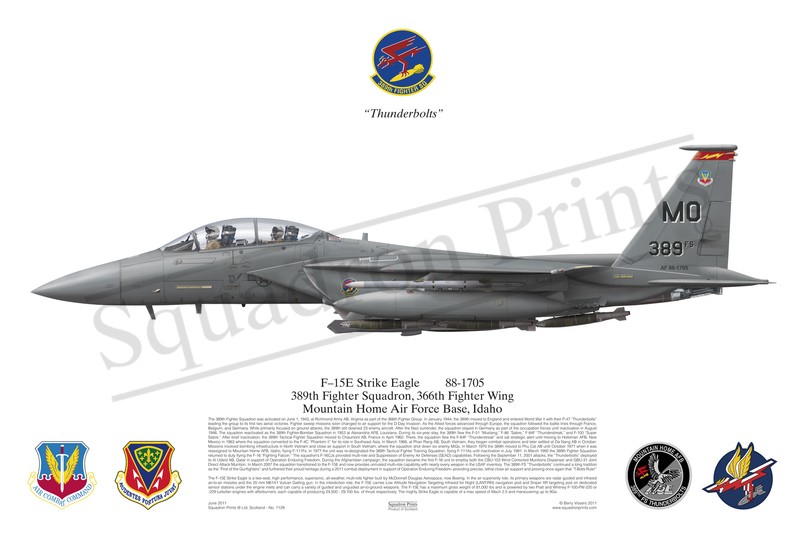#1129 F-15E Strike Eagle

Purchased products will not feature the Squadron Prints watermark
Description
Squadron Prints Lithograph No. 1129 - F-15E Strike Eagle, 88-1705, 389th Fighter Squadron, 366th Fighter Wing, Mountain Home Air Force Base, Idaho.
The 389th Fighter Squadron was activated on June 1, 1943, at Richmond Army AB, Virginia as part of the 366th Fighter Group. In January 1944, the 389th moved to England and entered World War II with their P-47 “Thunderbolts” leading the group to its first two aerial victories. Fighter sweep missions soon changed to air support for the D-Day Invasion. As the Allied forces advanced through Europe, the squadron followed the battle lines through France, Belgium, and Germany. While primarily focused on ground attacks, the 389th still downed 23 enemy aircraft. After the Nazi surrender, the squadron stayed in Germany as part of the occupation forces until inactivation in August 1946. The squadron reactivated as the 389th Fighter-Bomber Squadron in 1953 at Alexandria AFB, Louisiana. During its six-year stay, the 389th flew the F-51 “Mustang,” F-86 “Sabre,” F-84F “Thunderstreak,” and F-100 “Super Sabre.” After brief inactivation, the 389th Tactical Fighter Squadron moved to Chaumont AB, France in April 1962. There, the squadron flew the F-84F “Thunderstreak” and sat strategic alert until moving to Holloman AFB, New Mexico in 1963 where the squadron converted to the F-4C “Phantom II” for its role in Southeast Asia. In March 1966, at Phan Rang AB, South Vietnam, they began combat operations and later settled at Da Nang AB in October. Missions involved bombing infrastructure in North Vietnam and close air support in South Vietnam, where the squadron shot down six enemy MiGs. In March 1970 the 389th moved to Phu Cat AB until October 1971 when it was reassigned to Mountain Home AFB, Idaho, flying F-111Fs. In 1977 the unit was re-designated the 389th Tactical Fighter Training Squadron, flying F-111As until inactivation in July 1991. In March 1992 the 389th Fighter Squadron returned to duty flying the F-16 “Fighting Falcon.” The squadron’s F-16CJs provided multi-role and Suppression of Enemy Air Defenses (SEAD) capabilities. Following the September 11, 2001 attacks, the “Thunderbolts” deployed to Al Udeid AB, Qatar in support of Operation Enduring Freedom. During the Afghanistan campaign, the squadron became the first F-16 unit to employ both the CBU-103 Wind Corrected Munitions Dispenser and GBU-31 Joint Direct Attack Munition. In March 2007 the squadron transitioned to the F-15E and now provides unrivaled multi-role capability with nearly every weapon in the USAF inventory. The 389th FS “Thunderbolts” continued a long tradition as the “First of the Gunfighters” and furthered their proud heritage during a 2011 combat deployment in support of Operation Enduring Freedom--providing precise, lethal close air support and proving once again that “T-Bolts Rule!”
The F-15E Strike Eagle is a two-seat, high performance, supersonic, all-weather, multi-role fighter built by McDonnell Douglas Aerospace, now Boeing. In the air superiority role, its primary weapons are radar guided and infrared air-to-air missiles and the 20 mm M61A1 Vulcan Gatling gun. In the interdiction role, the F-15E carries Low Altitude Navigation Targeting Infrared for Night (LANTIRN) navigation pod and Sniper XR targeting pod on dedicated sensor stations under the engine inlets and can carry a variety of guided and unguided air-to-ground weapons. The F-15E has a maximum gross weight of 81,000 lbs and is powered by two Pratt and Whitney F-100-PW-220 or -229 turbofan engines with afterburners, each capable of producing 24,500 - 29,100 lbs. of thrust respectively. The mighty Strike Eagle is capable of a max speed of Mach 2.5 and maneuvering up to 9Gs.
You may also like
-
SALE RIAT 2018 Print Juno, Phenom, Sentinel, Atlas, F-35 Lightning
ZJ692; ZM334; ZM505; ZM416; ZM148RIAT 2018RAF Fairford
